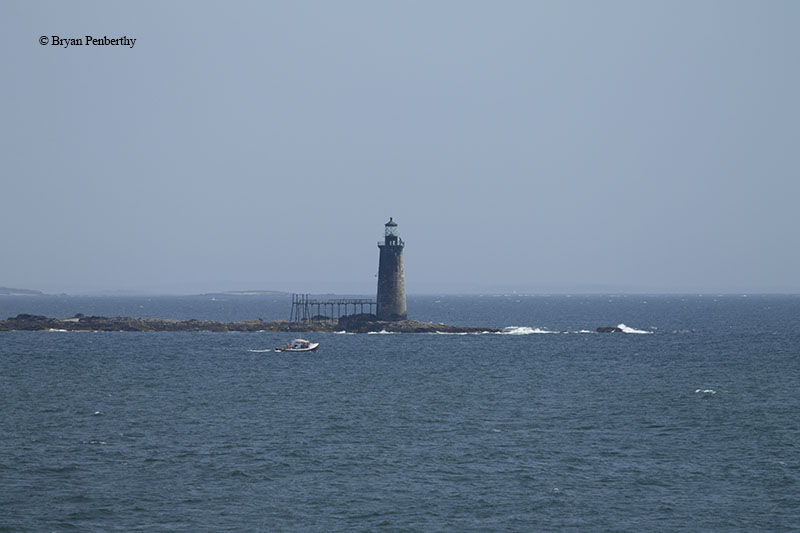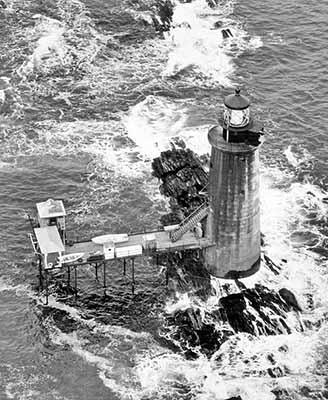Ram Island Ledge Lighthouse
Ram Island, Maine - 1905 (1905**)

History of the Ram Island Ledge Lighthouse
Posted/Updated by Bryan Penberthy on 2017-01-23.
Maine's Casco Bay is dotted with many islands and rocky ledges that make navigating its waters treacherous. To mark the eastern approach into Portland Harbor, the Lighthouse Board erected the Ram Island Ledge Lighthouse in 1905.
To make matters worse, many of the ledges, such as the Ram Island Ledge, are submerged at high tide, leaving unsuspecting mariners to believe there is enough water for safe passage.
As early as 1855, an iron spindle was placed on the ledge to function as a day mark, a purpose it would serve until being swept away by ice in 1868. It was quickly replaced by a 50-foot tall wooden tripod. Although these were fine during daylight hours and in clear weather, they were indistinguishable during periods of stormy weather and at night.
Many vessels met their demise on Ram Island Ledge. In fact, on May 27, 1866 alone, four vessels ran aground, luckily with no loss of life. Over the years, many more vessels would strike the ledge trying to make Portland Harbor during blustery weather.
Over the years, this scenario played out repeatedly. The final straw was the 400-foot trans-Atlantic Allan Line steamer Californian, leaving Portland just before midnight, bound for England. The vessel, with a crew of 96 and 21 passengers aboard, and a cargo valued at $300,000 ran aground on February 24, 1900 during a heavy snowstorm. Fortunately, there was no loss of life, and the vessel was able to be refloated six weeks later.
This near-disaster could have ended much differently, which was enough to convince the federal government that a lighthouse was needed at Ram Island Ledge. On June 28, 1902, Congress appropriated $83,000. By the following year, the Annual Report of the Lighthouse Board had the following entry detailing the progress:
68. Ram Island Ledge, entrance to Portland Harbor, Maine - The act approved on June 28, 1902, authorized the construction of a lighthouse and fog-signal on Ram Island Ledge at the entrance to Portland Harbor, Maine, at a total cost of $166,000, and appropriated $83,000 therefor. A further appropriation of $50,000 was made by the act of March 3, 1903. On September 15, 1902, the Light-House Board authorized the construction of the station by direct hire of labor and the purchase of materials of the lowest bidder, after due advertisement, in accordance with existing regulations. Title to the ledge for the site was obtained on March 10, 1903. The structure is to be a granite tower 28 feet in diameter at the base, 70 feet in height to the surface of the deck, consisting of 35 courses containing 699 stones. Detailed drawings of the masonry were made in the light-house engineer's office during the winter. On March 31, 1903, formal contract was made for the granite, to cost $33,679.40, and the first five courses have been completed at the works of the contractors ready for shipment. The site is a rock 1 mile outside of the entrance to Portland Harbor, fully exposed to the open sea. The foundation of the tower will be 3 feet above mean low water. As soon as the weather permitted, on May 1, 1903, work at the site was commenced. By June 30 the ledge was cut down and completely prepared for the foundation. A staunch timber bulkhead was bolted to the ledge, of about 100 running feet. It was built for the protection of the workmen and of the masonry in its earlier stages against the sea. A platform for materials, hoisting engine, and a derrick were built on the ledge adjacent to the tower. A store vessel is to be moored near the site. A small steamer for a tender between the site and Portland was hired for the season. Temporary quarters for workmen were built on Ram Island about 600 yards from the site.
Granite was to be sourced from the Bodwell Granite Company on Vinalhaven Island, then shipped to Central Wharf, where they were numbered, and then delivered to Ram Island Ledge. The cutting and leveling of the ledge started on May 1, 1903, and by July 9, the work of setting the massive blocks had begun.
 Ledge light circa 1951 (Courtesy CG)
Ledge light circa 1951 (Courtesy CG)
To secure the four-ton granite blocks to the ledge, four large bolts extended three feet into the ledge, and eight feet into the blocks. By the time to work had stopped for the winter on September 30, 1903, sixteen courses of granite blocks were laid, carrying the tower to a height of 32 feet.
Work resumed in April of 1904 and by June 30, all 699 granite blocks of the tower had been set. The lantern, lantern floor, and parapet were delivered and installed in September. The third-order Fresnel lens and illuminating apparatus were installed a few months later, in November.
Prior to the work stopping for the winter, on January 12, 1905, the Leona, a lime coaster from Rockland, Maine, bound for Rockport, Massachusetts, struck the ledge while trying to make Portland Harbor during a snowstorm.
As the captain and crew knew the lime would ignite when it came in contact with water, they evacuated in a life boat. After rowing for several hours against the storm, the captain fired a flare gun, which was spotted by the work crew on the nearby Ram Island who were able to rescue them. The Leona burned to the waterline.
William C. Tapley, the first keeper, placed the Ram Island Ledge Lighthouse into service on the night of April 10, 1905. The station's characteristic was two white flashes every six seconds, which was run by a mechanism that had to be wound every hour and a half.
The station employed three keepers, on a three week rotation. Each keeper worked two weeks at the lighthouse, and had one week shore leave. While at the station, each keeper worked 12-hour shifts.
Spring and early summer weather conditions delayed the construction of an iron pier on the western side of the ledge, which would provide a location for the oil house and fog bell tower. The work was completed by the end of summer, allowing the fog bell to be placed into operation on August 28, 1905. Its characteristic was a single blow every 10 seconds, when needed.
The station never had any modern conveniences. Even in 1950, the station still had a "two-holer" privy, located on the pier. During periods of inclement weather, there was a "slop bucket" under the sink, which would have to "carefully" be dumped overboard.
In late 1958, a submarine cable was laid from the Portland Head to Ram Island Ledge, allowing the Ram Island Ledge Lighthouse to be automated. The last keepers left Ram Island on January 14, 1959. The station's light and fog signal were then monitored remotely by Coast Guard personnel from the Portland Head Lighthouse.
That Ram Island Ledge Lighthouse was converted to solar power in January 2001. An array of solar panels was mounted on the south side of the tower, which provide power to a pair of batteries. The two batteries, then provided power the light and fog signal.
The station's original third-order Fresnel lens has since been replaced by a modern 300mm plastic optic, which still shows two white flashes every six seconds.
On August 30, 2008, the General Services Administration, through the National Historic Lighthouse Preservation Act of 2000, made the Ram Island Ledge Lighthouse available at no cost to any eligible federal, state, or local agency, non-profit corporation, or education agency provided the property was to be used for education, recreation, cultural, or historic preservation purposes.
When no acceptable applications were received, the General Services Administration made the lighthouse available to the general public via an online auction, which started on June 30, 2010. An initial bid of $10,000 was received within a few days of the start of the auction.
Most of the bidding took place near the end of the auction, after it entered its "soft closure" period in early September. During this time, a new bid had to be received each day, or the auction would end.
During the soft closure period, which ran from September 1 - 14, bidding rose incrementally from $30,000 to the winning bid of $190,000. The two bidders that did most of the bidding were Arthur P. Girard, a real estate developer from Portland, Maine, and Dr. Jeffrey Florman, a brain surgeon from Windham, Maine.
After driving the price up significantly, the two met at the entrance to the Maine Medical Center and decided to end the bidding process with a coin toss. When Dr. Florman won the coin toss, Arthur Girard stuck to his word, and stopped bidding on the granite tower.
Girard's quest to own a lighthouse wouldn't end there. He would go on to win the auction for the Boon Island Lighthouse in October 2014, with a bid of $78,000.
Dr. Florman says that he is "just a random guy who lives with his family in the woods." He purchased the unique property to be able to preserve it, and so far, has no particular plans for it yet.
Note: The lighthouse is private property, please respect this and do not trespass.
Reference:
- Annual Report of the Light House Board, U.S. Lighthouse Service, Various years.
- The Lighthouses of Maine: Southern Maine and Casco Bay, Jeremy D'Entremont, 2013.
- Lighthouses of Maine, Bill Caldwell, 1986.
- "Still in the dark about Ram Island Ledge Light," Trevor Maxwell, Portland Press Herald, June 20, 2011.
- "Picturesque Ram Island ledge lighthouse for sale," The Associated Press, Bangor Daily News, August 12, 2010.
- "Ram Island Ledge light off Cape Elizabeth for sale, in need of care," Amy Anderson, The Forecaster, July 22, 2010.
Directions: This lighthouse sits off-shore. Therefore, the best on-shore view is from the Portland Head Light. To get to Portland Head, take Cottage Road south out of South Portland. Cottage Road quickly turns to Shore Road. Continue south on Shore Road for about 1 mile to Fort Williams Park Road. Make a left into the park, and follow that east to the lighthouse.
Access: The lighthouse is privately owned. Grounds / tower closed.
View more Ram Island Ledge Lighthouse picturesTower Height: 72.00'
Focal Plane: 77'
Active Aid to Navigation: Yes
*Latitude: 43.63147 N
*Longitude: -70.18730 W
See this lighthouse on Google Maps.
